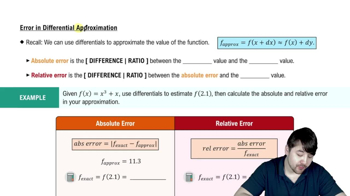Table of contents
- 0. Functions7h 52m
- Introduction to Functions16m
- Piecewise Functions10m
- Properties of Functions9m
- Common Functions1h 8m
- Transformations5m
- Combining Functions27m
- Exponent rules32m
- Exponential Functions28m
- Logarithmic Functions24m
- Properties of Logarithms34m
- Exponential & Logarithmic Equations35m
- Introduction to Trigonometric Functions38m
- Graphs of Trigonometric Functions44m
- Trigonometric Identities47m
- Inverse Trigonometric Functions48m
- 1. Limits and Continuity2h 2m
- 2. Intro to Derivatives1h 33m
- 3. Techniques of Differentiation3h 18m
- 4. Applications of Derivatives2h 38m
- 5. Graphical Applications of Derivatives6h 2m
- 6. Derivatives of Inverse, Exponential, & Logarithmic Functions2h 37m
- 7. Antiderivatives & Indefinite Integrals1h 26m
- 8. Definite Integrals4h 44m
- 9. Graphical Applications of Integrals2h 27m
- 10. Physics Applications of Integrals 2h 22m
4. Applications of Derivatives
Differentials
Problem 4.6.66
Textbook Question
Differentials Consider the following functions and express the relationship between a small change in x and the corresponding change in y in the form dy = f'(x)dx.
f(x) = (x+4)/(4-x)
 Verified step by step guidance
Verified step by step guidance1
First, identify the function given: \( f(x) = \frac{x+4}{4-x} \). We need to find the derivative \( f'(x) \) to express the differential \( dy \).
Apply the quotient rule for differentiation, which states that if \( f(x) = \frac{u(x)}{v(x)} \), then \( f'(x) = \frac{u'(x)v(x) - u(x)v'(x)}{(v(x))^2} \). Here, \( u(x) = x+4 \) and \( v(x) = 4-x \).
Calculate the derivatives: \( u'(x) = 1 \) and \( v'(x) = -1 \).
Substitute these into the quotient rule formula: \( f'(x) = \frac{(1)(4-x) - (x+4)(-1)}{(4-x)^2} \). Simplify the expression to find \( f'(x) \).
Finally, express the differential relationship as \( dy = f'(x)dx \), where \( f'(x) \) is the simplified derivative from the previous step.
 Verified video answer for a similar problem:
Verified video answer for a similar problem:This video solution was recommended by our tutors as helpful for the problem above
Video duration:
2mPlay a video:
Was this helpful?
Key Concepts
Here are the essential concepts you must grasp in order to answer the question correctly.
Differentials
Differentials represent the relationship between small changes in variables. In calculus, if y is a function of x, the differential dy is defined as dy = f'(x)dx, where f'(x) is the derivative of the function. This concept allows us to approximate how a small change in x (denoted as dx) affects the change in y (denoted as dy).
Recommended video:

Finding Differentials
Derivatives
The derivative of a function measures the rate at which the function's value changes as its input changes. It is defined as the limit of the average rate of change of the function over an interval as the interval approaches zero. In the context of the given function, f'(x) will provide the slope of the tangent line at any point on the curve, which is essential for calculating dy.
Recommended video:

Derivatives
Function Composition
Function composition involves combining two functions to create a new function. In this case, understanding how the function f(x) = (x+4)/(4-x) behaves is crucial for finding its derivative. Analyzing the function's structure helps in applying the quotient rule for differentiation, which is necessary for determining f'(x) and subsequently expressing dy in terms of dx.
Recommended video:

Evaluate Composite Functions - Special Cases






